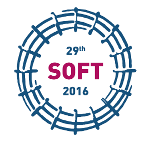Speaker
Anders Hjalmarsson
(Department of Physics and Astronomy)
Description
The High Resolution Neutron Spectrometer (HRNS) system for ITER is an array of neutron spectrometers with the primary function to provide measurements of the fuel ion ratio, nT/nD, in the plasma core. Supplementary functions are to assist or provide information on fuel ion temperature and energy distributions of fuel ions and confined alpha-particles. The ITER requirement for the HRNS primary function is to obtain nT/nD with 20% uncertainty and a time resolution of 100 ms.
In this contribution, a conceptual HRNS system design and its measurement performance for nT/nD will be presented. The HRNS system studied, is based on established instrumental techniques and its performance is assessed using realistic response functions for the individual spectrometers in the system. The main interfacing requirements for the HRNS is a 10 cm diameter aperture in the ITER first wall, tapered collimation resulting in a neutron flux in the order of 1099 n/cm22/s on an area of 12 cm22 at a distance of 16 m from the first wall.
For optimum use of the available neutron flux, the system is divided into two sections; “low efficiency” neutron spectrometers in the front and “high efficiency” in the rear. Also investigated is to use an adjustable collimator between the front and rear spectrometers in order to enhance the dynamic range and overlap of the two sections.
For the combination of neutron spectrometers presented here, it is shown that the system fulfills the ITER requirement, on nT/nD, over an order of magnitude in fusion power, 50 < Pfus < 500 MW. In the performance study, contributions due to neutron scattering in the vessel walls, collimator and beam dump are included together with a neutron induced gamma background.
Co-authors
Anders Hjalmarsson
(Department of Physics and Astronomy, Uppsala University, Uppsala, Sweden)
Andrzej Igielski
(Institute of Nuclear Physics, Polish Academy of Sciences, Kraków, Poland)
Arkadiusz Kurowski
(Institute of Nuclear Physics, Polish Academy of Sciences, Kraków, Poland)
Benjaminas Marcinkevicius
(Department of Physics and Astronomy, Uppsala University, Uppsala, Sweden)
Benoit Brichard
(Fusion for Energy, Barcelona, Spain)
Carl Hellesen
(Department of Physics and Astronomy, Uppsala University, Uppsala, Sweden)
Erik Andersson-Sunden
(Department of Physics and Astronomy, Uppsala University, Uppsala, Sweden)
Giuseppe Mazzone
(ENEA C. R. Frascati Dipartimento FSN, Frascati, Italy)
Goran Ericsson
(Department of Physics and Astronomy, Uppsala University, Uppsala, Sweden)
Grzegorz Tracz
(Institute of Nuclear Physics, Polish Academy of Sciences, Kraków, Poland)
Jacob Eriksson
(Department of Physics and Astronomy, Uppsala University, Uppsala, Sweden)
Jurek Kotuła
(Institute of Nuclear Physics, Polish Academy of Sciences, Kraków, Poland)
Krzysztof Drozdowicz
(Institute of Nuclear Physics, Polish Academy of Sciences, Kraków, Poland)
Leszek Hajduk
(Institute of Nuclear Physics, Polish Academy of Sciences, Kraków, Poland)
Luca Giacomelli
(Istituto di Fisica del Plasma “P. Caldirola”, Consiglio Nazionaledelle Ricerche, Milano, Italy)
Marco Tardocchi
(Istituto di Fisica del Plasma “P. Caldirola”, Consiglio Nazionaledelle Ricerche, Milano, Italy)
Marek Scholz
(Institute of Nuclear Physics, Polish Academy of Sciences, Kraków, Poland)
Sean Conroy
(Department of Physics and Astronomy, Uppsala University, Uppsala, Sweden)
Urszula Woznicka
(Institute of Nuclear Physics, Polish Academy of Sciences, Kraków, Poland)

